Introduction
The housing market of Canada is managed and governed by the Canada Mortgage and Housing Corporation. It provides up-to-date and reliable reports, which help monitor the Canadian housing market, analyze it, and make predictions about its development. This resource provides data related to the rental market, housing construction, mortgage loans, social housing, and other aspects important for the housing market. Despite the existing problems, which result from economic crises, the Canadian housing market remains balanced. As of November 2017, its sales-to-new listings ratio was 0.56 (King, 2018). In February 2018, this ratio still indicated the balanced market and was estimated at 0.55. According to RBC economic research, a decline of 13.8% in home sales was observed in January, which is typical of this period (“Monthly housing market update,” 2018). The number and dynamics of housing starts, completions, dwellings under construction, and market absorption are among the indicators, reflecting the condition of the housing market. The current report analyzes these indicators of the Canadian housing market for the period from 1990 to 2015, thus comprising a 26-year period.
Housing Starts
Housing starts are an indicator, which, to some extent, mirrors the strength of the country’s economy. An increase in newly-built houses indicates the growth of the overall prosperity and buying ability of the citizens. An increase in demand for dwelling construction is favorable for the economy on the whole and construction industry, particularly since it stimulates employment. Moreover, new dwellings will increase demand for household goods and appliances, contributing to the development of the economy. While housing starts depend on the area and the season, this analysis includes annual data. The data for housing starts in Canada from 1990 to 2015 are presented in Table 1. Still, the dynamic changes are better traced in Figure 1.
After some years of sustainability in housing starts in the period from 2003 to 2007, a decline in housing starts of 7.6% from 228,343 to 211,056 units in 2008 and further sharper reduction of 29.4% (to 149,081 units) in 2009 was a consequence of the financial crisis of 2007-2008. The crisis led to a GPD decrease, which took the economy of Canada into recession. It had a significant impact on workers’ employment and salary, which finally resulted in the reduction of buying capacity and, consequently, a decrease in demand for new dwelling construction.
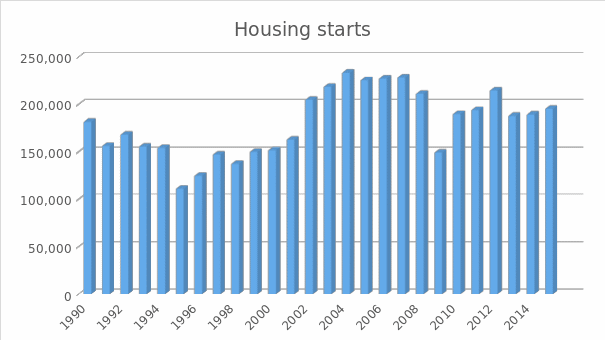
An increase in housing starts by 10.8% was observed in 2012. One of the possible reasons for this increase was international migration, which conditioned an increase in the Canadian population at that time (“Canadian housing observer 2014,” 2014). Still, the year 2013 is characterized by the reduction of housing starts by 12.5%, which was not so sharp. There were 187,923 units of housing started, and this number was not lower than the average of 179.608 units for the period from 1990 to 2015. One of the reasons for the decrease was the economic crisis of 2012, which did not have a significant impact on Canada. Still, it influenced the emerging economies and stimulated further international migration. This fact also contributed to decreased single housing starts and a simultaneous increase in multiple housing construction. Already in 2008, multiple housing starts exceeded single. Still, the difference between these two types of construction in 2012 was unprecedentedly big. For only 83,657 units of single housing starts, there were 131,170 units of single ones (See Table 2 and Figure 2 for more detailed information).
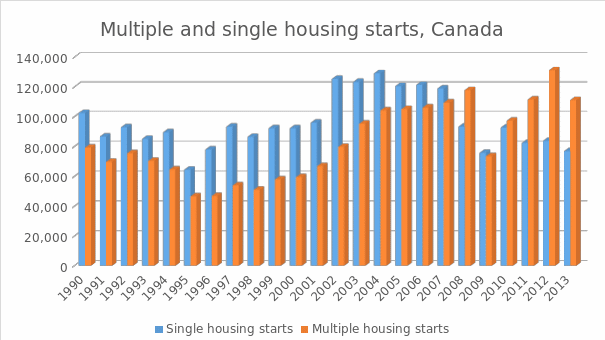
On the whole, recent years are characterized by an increase in housing starts in Canada. The Canadian housing predictions include the preservation of regional and seasonal disparities (“Housing market outlook. Canada edition,” 2016). The stabilization of the housing market is expected in 2018.
Housing Completions
Housing completions make one more indicator of success in the housing industry. Annual data for this indicator include all housing units completed within the current year, disregarding the date of their start. Housing completions can be a more important factor for construction success because they reflect the condition of the economy. An increase in housing completions usually means that there is enough funding and that the estimated construction budgets are followed. On the contrary, a decrease in housing completions indicates a lack of finance in construction companies and overall financial instability.
In Canada, within the estimated period from 1990 to 2015, there were some peaks and declines in dwelling construction completions. The change in the number of housing completions partially follows, although it does not exactly correspond to the Canadian GDP change. In the mid-90s, there was a decline, which was followed by growth and sustainability until 2008. Table 3 and Figure 3 present the picture of housing completions in Canada within the analyzed period.
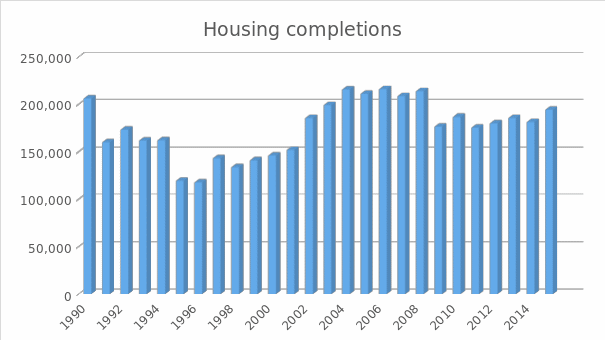
Thus, after seven years of sustainable completions, the year 2009 came with a decrease of 17.6% and 176,441 of completed units. Nevertheless, this figure was not smaller than the average completions’ number of 174,921. At present, the number of housing completions demonstrates a tendency for a slight increase. Still, no significant changes are expected.
Dwellings under Construction
Dwellings under construction make a category of objects that comprise all housing units, which were in construction but were not completed every year. The difference between the number of housing units started earlier and those completed during a year. The changes in the number of dwellings under construction can be traced in Figure 4.
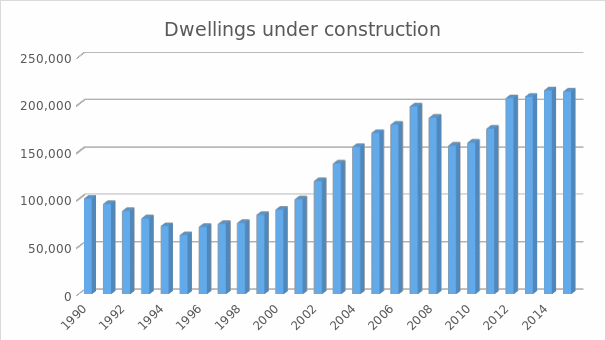
Increases in the number of dwellings under construction are evident after the years 2000 and 2012, characterized by the population increase, both natural and due to migration. A decrease of 15.9% in 2009 can be attributed to the consequences of the financial crisis of 2008. In the period after 2012, the number of dwellings under construction increased, which is a consequence of a decrease in housing completions due to the crisis. In case the rate of completions increases, the number of dwellings under construction is supposed to reduce in the following years.
Market Absorption
Market absorption in housing can be presented by a rate, which reflects how housing units are sold at a definite period. It is a necessary indicator, which can help in predicting prices in real estate and sales. There are no data on housing market absorption in Canada before 2013. Therefore, this part of the report uses data for five recent years and comprises homeowners and condominium units. Figure 5 shows no significant changes in the number of absorbed and unabsorbed housing units from 2013 to 2017 (“Absorbed units by price range,” 2018). See Table 4 for detailed data.
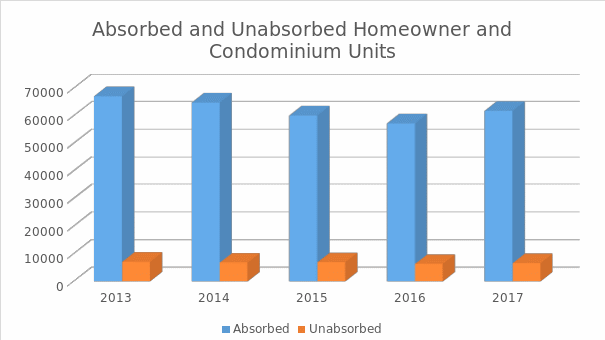
According to the “Canadian housing health check” (2017), the peak of unabsorbed housing units was recorded in 1989, and there was a tendency to a decrease since then. Already in February 2016, the unabsorbed inventory was 0.20 units per 1,000 population. It means that the Canadian housing market is within a safe zone because the threshold indicating the mild excess supply is estimated at 0.27. As for the multi-unit dwellings, market absorption has been sustainable within the last two years (“Canadian housing health check,” 2017).
Comparative Analysis of Data
It can be useful to compare the data about starts, completions, and dwelling under construction and trace their interrelations. Table 5 summarizes all numbers from 1990 to 2015. Figure 6 provides a graphic representation of housing starts, completions, and dwellings under construction, which provides an opportunity to compare the tendencies in these processes. The diagram demonstrates correlating changes from 1990 to 2008, which means that these three housing market components are interrelated.
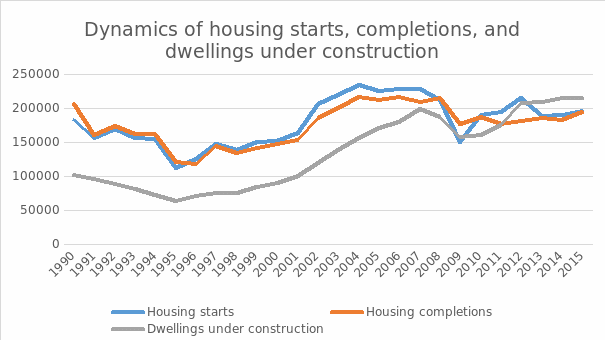
On the whole, the housing market greatly depends on the country’s economy. Speaking of the Canadian housing market, it is also under the impact of the United States’ economy due to the location of countries and their close cooperation (Li & Li, 2012). Thus, an increase in GDP at the beginning of 2005 had a positive influence on the development of the housing market and was followed by the growth of starts and completion rates in 2008. At the same time, the global financial crisis of 2008 caused a drop in construction. Another interesting aspect typical of the Canadian housing market on the whole and newly built residential in particular, is its seasonal character. Thus, the first two quarters are usually more active while the activity decreases in the third and fourth quarters (Li & Li, 2012).
On the whole, the current condition of the housing market in Canada observes a tendency to grow. “Preliminary housing start data” report (2018) discloses data for January and February of 2018 compared to the same period of 2017 for centers with 10,000 and over. The change in housing starts by province can be traced in Figure 8. The majority of provinces showed have fewer housing starts compared to the same period of 2017. Still, the general increase in 2018 is estimated at 11%, and it can be even bigger because January is traditionally not a very busy month for construction start. At the same time, there is a decrease of 9% in single-detached housing starts, and an increase of 20% in other housing starts (“Preliminary housing start data,” 2018). Thus, it can be concluded that the Canadian housing market demonstrates the predicted sustainability.
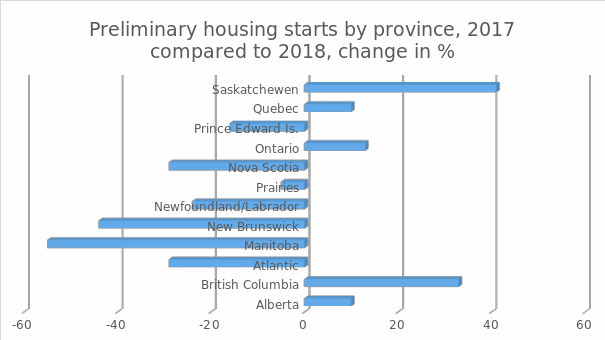
Conclusion
Overall, the report provides a vision on such aspects of Canada’s housing market as construction. It comprises data from Canada Mortgage and Housing Corporation for the period from 1990 to 2015 for most issues except for market absorption. It can be concluded that the number of housing starts, housing completions, and dwellings under construction in the Canadian market is determined by a complex of factors. The most significant factor influencing the housing market is the economics of the world on the whole and the country in particular. Thus, global economic crises resulted in substantial decreases in numbers of housing starts and completions while the rates of dwellings under construction increased. The other factors are political and social, which are usually combined. For example, social and political problems in other countries stimulate migration to developed countries with a reliable economic situation. As a result, the population increases, causing the growth of demand for new houses. At present, the Canadian housing market looks sustainable and is one of the best-developed housing markets in the world.
References
Absorbed units by price range. (2018). Web.
Canadian housing health check. (2017). Web.
Canadian housing observer 2014. (2014). Web.
CHS – Residential building activity. (2016). Web.
Housing market outlook. Canada edition. (2017). Web.
King, R. (2018). Canadian real estate market outlook 2018. Macleans.
Li, R. Y. M., & Li, J. (2012). The impact of subprime financial crisis on Canada and United States housing market and economy. Proceedings of ICBMG Conference, vol. 59, pp. 1-6, Hong Kong.
Monthly housing market update. (2018). Web.
Preliminary housing start data. (2018). Web.